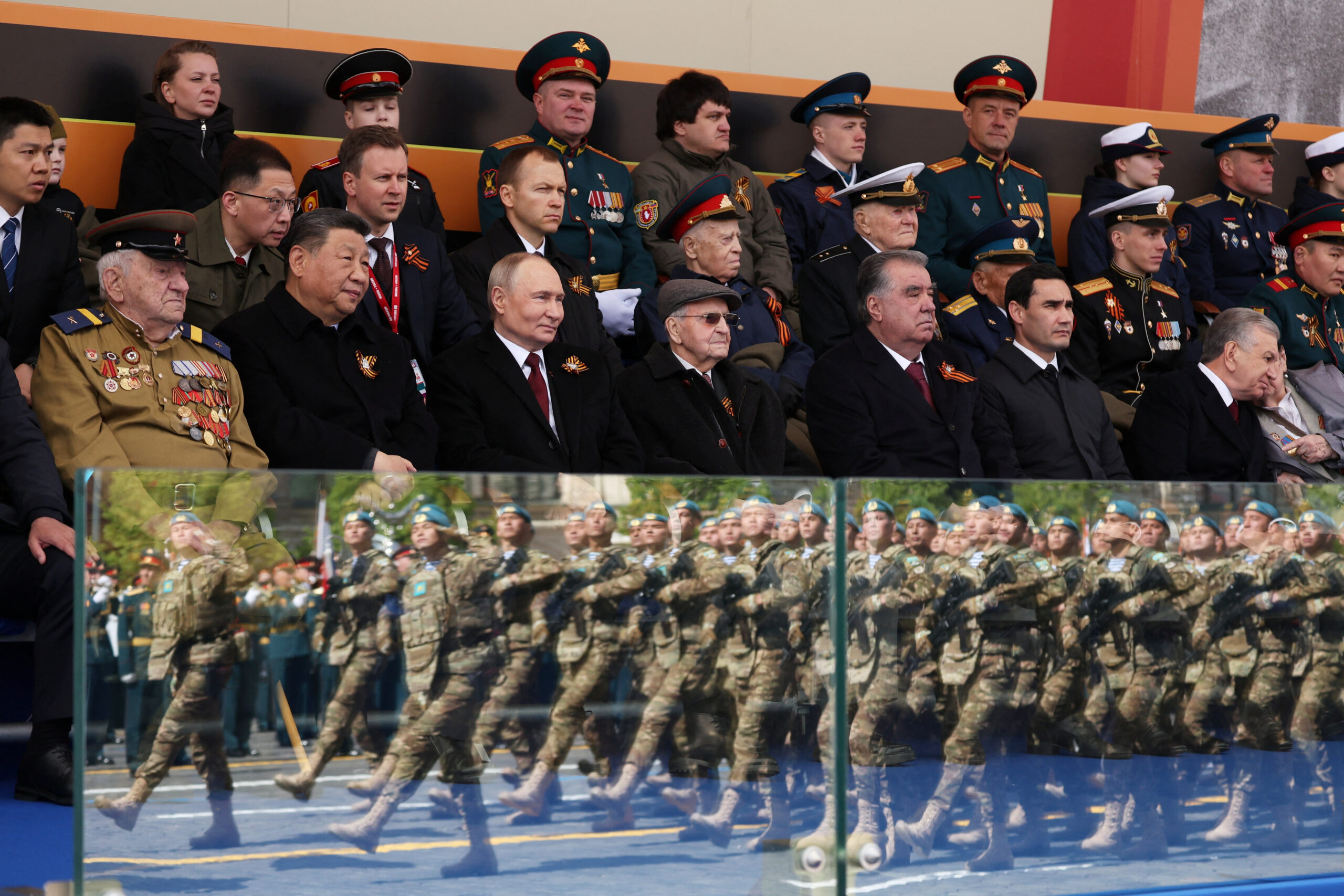Russia marked the 80th anniversary of its victory over Nazi Germany on Thursday with a large-scale military parade on Red Square, where Russian President Vladimir Putin praised the legacy of Soviet soldiers and described modern Russia as a bulwark against Nazism.
Flanked by some 20 heads of state and government — including Chinese President Xi Jinping, Venezuela’s Nicolás Maduro, Brazil’s Luiz Inácio Lula da Silva, Serbia’s Aleksandar Vučić and Slovak Prime Minister Robert Fico, the only EU leader in attendance — Putin cast the Soviet triumph as the foundation of modern Russian identity.
“Our fathers, grandfathers and great-grandfathers saved the Fatherland and left us the duty to defend it, to remain united, to protect our thousand-year history, culture and traditional values,” Putin said in a speech lasting just under ten minutes.
The Russian leader then shifted to a more pointed message: “Russia has been and will remain an impenetrable barrier against Nazism, Russophobia and anti-Semitism.” Since 2020, Russia’s penal code has prescribed up to five years in prison for those convicted of “rehabilitating Nazism,” including for referencing Soviet-era policies like the Molotov–Ribbentrop Pact that divided Poland between Hitler and Stalin.
Putin called Victory Day “the most important holiday for every Russian citizen,” invoking the postwar peace as the product of sacrifice by a generation of veterans who showed “sincere devotion to the Fatherland, determination to defend the country, and the values of humanism and justice.”
More than 11,500 uniformed personnel took part in Friday’s morning parade, including members of the Armed Forces, the FSB, the National Guard, and the Ministry of Emergency Situations — alongside over 1,500 veterans of the war in Ukraine. Military units from 13 nations, including China, Egypt, Vietnam, Turkmenistan, Kyrgyzstan, Laos and Mongolia, also took part.
Under the gaze of the 16th-century St. Basil’s Cathedral, some of the hardware from the ongoing conflict in Ukraine took center stage: BRM-1K combat reconnaissance vehicles, 152mm self-propelled artillery systems like the Giatsint-K and Malva, and an array of surveillance and strike drones including the Orlan-10, Orlan-30, Zala, Lancet-51 and -52, Harpy and Geran. The display also included Iskander ballistic missiles, Tornado-S multiple rocket launchers, and TOS-2 Tosochka thermobaric flamethrower systems. The skies were patrolled by the Russian Knights and Swifts aerobatic teams, joined by Su-30 and MiG-29 fighter jets.

Still, this year’s Victory Day carried a more subdued note for many Russians who had hoped the May 9 celebrations would coincide with the end of fighting in Ukraine. Putin, however, insisted the public remains behind the campaign: “Truth and justice are on our side. We must defend the honor of the Red Army’s soldiers and commanders.”
Polling tells a more nuanced story. According to an April 2025 survey by the independent Levada Center, just 30% of Russians supported continuing the war — the lowest figure since the invasion began three years ago. That number dropped to 18% among those aged 18 to 39, but rose to 40% among respondents over 55. Meanwhile, 61% said they favored opening negotiations with Kyiv, and 40% believed the war had done more harm than good for Russia.
Notably, Putin’s address omitted any express mention of the West. Just a year ago, the Russian president had used the same Red Square podium to condemn Western powers as “colonial, hypocritical and revanchist” and accused them of distorting the real history of World War II.
This year, Putin reiterated the paramount role the USSR played in defeating Nazi Germany, adding that the so-called second front in Western Europe — which was opened after the 1944 Normandy landings — was made possible only by what he called “decisive battles” fought on Soviet territory.
On the sidelines of the ceremony, attention also turned to an informal meeting between Putin and Xi. The Chinese president’s visit reignited speculation over Power of Siberia 2, a proposed gas pipeline that would carry Siberian natural gas from Russia to China via Mongolia.
First pitched by Moscow in 2022 as a partial substitute for lost European markets, the project has stalled over price disagreements. Beijing has insisted on receiving gas at Russia’s subsidized domestic rate, at around $70–$100 per 1,000 cubic meters (cbm). According to sources cited by Bloomberg, Chinese officials may now be open to a compromise price between the domestic rate and the one paid under the existing Power of Siberia pipeline ($150–$180 per 1,000 cbm), which reached full capacity of 38 billion cbm in 2023.
A final deal, however, is not expected during Xi’s trip. Chinese officials reportedly favor a route that circumvents Mongolia. For Gazprom, whose European market has largely evaporated since the invasion of Ukraine, Beijing represents one of the few remaining lifelines. Exports to Europe have fallen from around 150 billion cbm a year to just 40 billion, according to BCS. Brussels, meanwhile, remains committed to phasing out all Russian gas imports by 2027.
Even if Power of Siberia 2 and other projects are completed and operate at full capacity, total Russian gas exports to China would reach only 98 billion cbm per year—less than two-thirds of prewar volumes to Europe.
As military grandeur played out on Red Square, Brussels turned its focus to Ukraine’s defense. On Friday, European Commission President Ursula von der Leyen announced a €1 billion package — funded through interest on frozen Russian assets — to support Ukraine’s defense industry.
“These funds will go directly to Ukrainian defense companies,” EU foreign policy chief Kaja Kallas said. “They will help ensure continued supplies of military equipment in the critical months ahead.”
Roughly €300 billion in Russian central bank assets remain frozen, primarily in European institutions. Moscow has repeatedly dismissed the idea as a form of financial piracy.












